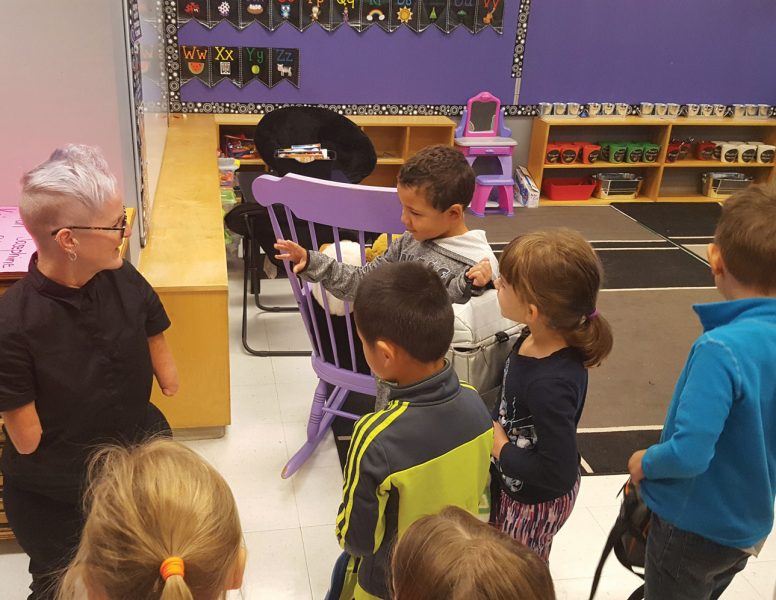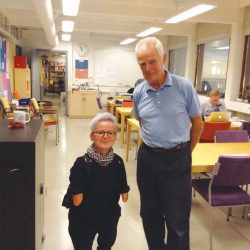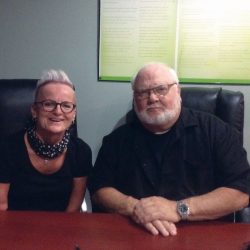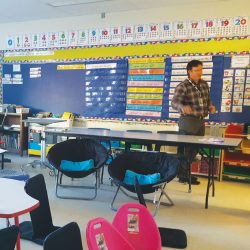Finland & Canada: what can we learn?
ALLFIE’s Director, Tara Flood, reports back on her travels through Finland and Canada, finding out about inclusion in schools there.

I think many readers would agree that progress towards an inclusive education system in the UK has got a bit stuck. The UN Disability Committee agrees and goes further in saying that the UK Government is in breach of its Convention obligations by reversing and restricting the development of inclusive education.
So I’ve been thinking for a while about how to find a positive response to what feels like a very bleak situation. My conclusion was that I needed to look beyond the UK for inspiration bearing in mind that the UK is one of only two countries to restrict its obligations under Article 24 of the UNCRPD. Could I find a more positive approach to inclusive education elsewhere? A colleague told me about the Winston Churchill Travel Fellowship scheme – www.wcmt.org.uk – set up for people in the UK to travel abroad to investigate new ways of doing things and bring back ideas to improve practice here. So in September 2017 I applied to visit Finland and New Brunswick in Canada to investigate levels of inclusivity in their education systems.
I chose Finland because according to UNICEF it tops the rankings in having happy children. Interestingly for those people who measure success by academic attainment, Finland has also been for a number of years now at or close to the top of the PISA (Programme for International Student Assessment). New Brunswick in Canada is known for taking the brave political decision to close all its special schools in the late 80s in pursuit of a fully inclusive education system. So after months of planning, I arrived in Helsinki for the first part of my trip at the end of August.
In both countries I had the opportunity to meet disability and human rights activists, parents and families of Disabled children and young people, government representatives, academics, service providers and community support organisations and to visit some truly amazing schools.

The first thing to report from Finland is that it has all the elements required to deliver an inclusive education system, but sadly it is not fully inclusive. The law and constitution strongly support inclusion. Teachers and support staff are very well educated, trusted and respected – for example there is no OFSTED equivalent. The education system is well funded. In 2014, Finland spent $13,865 per student in lower secondary school, compared to the OECD average of $10,235. Total spending on education represented 5.7% of Finland’s GDP in 2014, compared to the average across OECD countries of 5% in 2014. Funding has declined recently, but is significantly higher than in similar economies. Education at all levels is free and genuinely young person focussed. Schools have complete autonomy over the curriculum and how they assess pupil learning. Children don’t start formal education until 6/7 years with a year of kindergarten before starting school. Class sizes are smaller (average 20 pupils per class) and in all the schools I visited, teachers and support staff focus on getting to know every child to understand their strengths and challenges.
I was disappointed to discover there are still six special schools, but all of those are part of a decade long initiative to become Development Centres with a focus on building the capacity of their local mainstream schools to be more inclusive. Unfortunately because this transition isn’t monitored and there is little political leadership, limited progress has been made. In fact a number of parents I met felt progress towards greater inclusion was actually in decline. This is despite the Finnish Government ratifying the UNCRPD in 2016 and having a new UNCRPD Action Plan with a clear goal for the education system to become fully inclusive of all pupils & students. Finland has around 0.5m pupils & students in full time education and around 43,000 Disabled pupils & students in education (defined as receiving special support), 10% of whom are in special school (Source: Education Statistics Finland).
I spent a day at the Granhultsskolan in Grankulla, a Swedish speaking school with 367 1st to 6th grade pupils. I was struck in all the schools I visited by the welcoming environment. Staff and pupils wear socks or slippers rather than shoes. Finnish schools seem very community focussed and Granhultsskolan has a volunteer programme for retired people, known as “grandparents”, to help children in the classroom and provide a family feel.
I visited five schools in and around Helsinki and found a strong focus on culture, the arts, handicrafts, community and nature. I found an ethos of learning not for school, but for life. Headteachers all talked about their love for teaching and for their children. Marja Perkkiö, Headteacher, Westendinpuiston koulu in Espoo said “We don’t see difference as a big deal so the children pick up on this – we see all diversity as a good thing – it is just the ethos of the school – children and teachers respect each other”.
I was also impressed with the non governmental sector in Finland: it’s incredibly vibrant, well organised and well resourced. Disabled person led organisations, parent led organisations and service providers seem to work well together, but many talked about frustration with government officials and politicians who are complacent after years of political consensus. Some national NGOs recently set up an Article 24 action group and are lobbying the government to commit to full inclusion.
Despite some of the excellent practice I saw in Finnish schools, I arrived in New Brunswick (NB) feeling a bit deflated about the gap in Finland between the vision for educational inclusivity and the reality of Disabled pupils being marginalised due to misconceptions about additional cost and a lack of will across the teaching sector to see they should be teachers of ALL children.
New Brunswick has had a commitment to inclusion since the passage of Bill 85 in 1986, a vision maintained by successive provincial governments. Bill 85 effectively outlawed segregated education, with the closure of all segregated provision and a programme to build the capacity of “regular” schools. This was driven by long time advocate for inclusive education and Director of Inclusive Education Canada, Dr. Gordon Porter, with Julie Stone, Ken Pike, Krista Carr, leaders and parents.

In NB I visited a children’s centre, two elementary schools (kindergarten to 5th grade), 1 middle school (6th – 8th grade) and 1 high school (9th – 12th grade) and in every school I met staff who spoke with real passion about inclusion and a belief that every student at the school had a right to be there and get the support they need to learn and participate in all aspects of school life. They were honest about the challenges which inevitably include not enough money, but also the need for good practice to be shared and spaces for staff to share ideas, learning and practical assistance. For example I met a 7th grade student (14 years) in Devon Middle School with labels around communication, autism and ‘challenging’ behaviour who was spending most of her time outside the classroom because she finds the noise and movement of others difficult and it was clear she felt more comfortable learning if able to move around or stand. Teachers and resource staff (resource staff are qualified teachers whose role is to capacity build the staff team and provide additional learning support for pupils & students with Individual Learning Plans) were working together but struggling to find solutions. Yet on the other side of Fredericton, I visited Park St Elementary where all the classrooms had a range of seating/standing options, including an exercise bike for students needing to work off extra energy.
Universal accommodations (adjustments) are at the heart of the NB education system: inclusion is about ALL pupils and students – Disabled, First Nation, LGBTQI. Practically this means any student can take time out of the classroom to study elsewhere in the school; any student can request additional time for assessments. It also indicates a trust in self-directed learning for students.
Realising inclusion in secondary school in the UK is notoriously difficult and the same is true in NB. I spent the day in Fredericton High School which has 1,900 students (not that big by UK standards), where they provide a combination of immersive and individualised learning for a diverse group of learners. The Principal, Nathan Langille, and his team recognise inclusion isn’t perfect at the school and they have initiatives to help build friendships between all students. He was clear that it wasn’t appropriate to have separate programmes for Disabled students as this would “build bigger barriers between students”.

In NB I had the opportunity to meet senior civil servants at the Department of Education & Early Childhood Development. This was an extraordinary meeting because of the clarity of their commitment to realising inclusive education and their continuing work to develop their understanding of how to support schools as ‘common learning environments’ (Policy 322). Kim Korotkov, Head of Education Support Services said: “We have had an inclusive education system here for 30 years now. We would never go back to a time where we would separate out certain groups of children. It’s not perfect here but it’s the right thing to do.”
I am still writing up my report for the WCMT, but thought it would be timely to share some of my early thinking about what I saw in Finland and New Brunswick and what we can learn from their systems. My report to the WCMT will include ideas for how we put the brakes on Government’s plan to reverse the “bias towards inclusion” and restart progress towards a fully inclusive system.
So where do we need to start, or at the very least refresh our work In the words of Gordon Porter we need to “normalise inclusion”. We need to shift focus away from individualising Disabled pupils & students and take a whole school approach which seeks to construct community in our classrooms. We need to move away from competition and elitism. We need to acknowledge that inclusion isn’t easy and we are unlikely to reach a point where we can sit back and say we’ve done it! Inclusion is a process of continued learning, challenge and evolution AND that’s OK.
We need to provide the training and professional development climate that supports teachers to be teachers of all students. We need to ensure families are confident their local school will not only welcome their child, but have the resource and knowledge to support the child to participate in learning. We need to find new ways to mobilise the voluntary and community sector to challenge their local education providers to become inclusive and to better reflect the diversity of their community.
For me the Finnish education system sets out what we know must change in terms of valuing ALL children whatever their learning ability or style and that equality and love must be at the heart of any education system. New Brunswick affirmed what ALLFIE has said for many years – that inclusive education requires an end to segregation. New Brunswick is not only the example that proves this, but also the real time case study that shows how inclusive education is possible for ALL pupils & students, is sustainable and anything but static.
Tara Flood
Director, the Alliance for Inclusive Education
![Allfie [logo]](https://www.allfie.org.uk/wp-content/themes/allfie-base-theme/assets/img/allfie-logo-original.svg)



